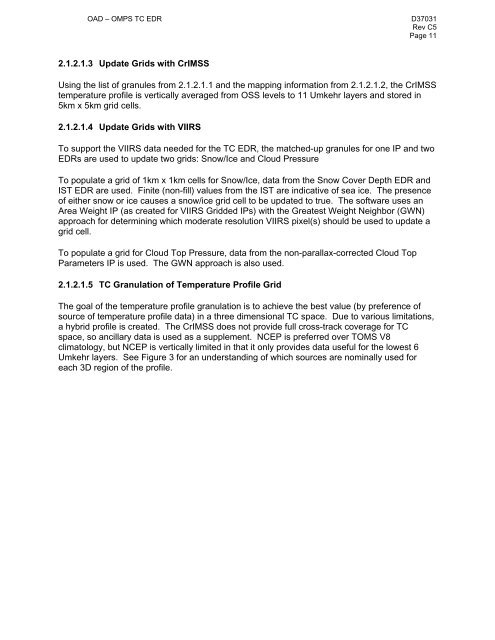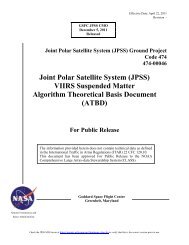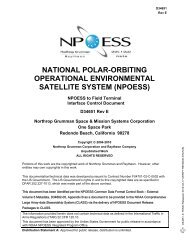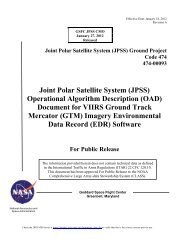(OAD) Document for Ozone Mapping and Profiler Suite ... - NASA
(OAD) Document for Ozone Mapping and Profiler Suite ... - NASA
(OAD) Document for Ozone Mapping and Profiler Suite ... - NASA
Create successful ePaper yourself
Turn your PDF publications into a flip-book with our unique Google optimized e-Paper software.
<strong>OAD</strong> – OMPS TC EDR D37031<br />
Rev C5<br />
Page 11<br />
2.1.2.1.3 Update Grids with CrIMSS<br />
Using the list of granules from 2.1.2.1.1 <strong>and</strong> the mapping in<strong>for</strong>mation from 2.1.2.1.2, the CrIMSS<br />
temperature profile is vertically averaged from OSS levels to 11 Umkehr layers <strong>and</strong> stored in<br />
5km x 5km grid cells.<br />
2.1.2.1.4 Update Grids with VIIRS<br />
To support the VIIRS data needed <strong>for</strong> the TC EDR, the matched-up granules <strong>for</strong> one IP <strong>and</strong> two<br />
EDRs are used to update two grids: Snow/Ice <strong>and</strong> Cloud Pressure<br />
To populate a grid of 1km x 1km cells <strong>for</strong> Snow/Ice, data from the Snow Cover Depth EDR <strong>and</strong><br />
IST EDR are used. Finite (non-fill) values from the IST are indicative of sea ice. The presence<br />
of either snow or ice causes a snow/ice grid cell to be updated to true. The software uses an<br />
Area Weight IP (as created <strong>for</strong> VIIRS Gridded IPs) with the Greatest Weight Neighbor (GWN)<br />
approach <strong>for</strong> determining which moderate resolution VIIRS pixel(s) should be used to update a<br />
grid cell.<br />
To populate a grid <strong>for</strong> Cloud Top Pressure, data from the non-parallax-corrected Cloud Top<br />
Parameters IP is used. The GWN approach is also used.<br />
2.1.2.1.5 TC Granulation of Temperature Profile Grid<br />
The goal of the temperature profile granulation is to achieve the best value (by preference of<br />
source of temperature profile data) in a three dimensional TC space. Due to various limitations,<br />
a hybrid profile is created. The CrIMSS does not provide full cross-track coverage <strong>for</strong> TC<br />
space, so ancillary data is used as a supplement. NCEP is preferred over TOMS V8<br />
climatology, but NCEP is vertically limited in that it only provides data useful <strong>for</strong> the lowest 6<br />
Umkehr layers. See Figure 3 <strong>for</strong> an underst<strong>and</strong>ing of which sources are nominally used <strong>for</strong><br />
each 3D region of the profile.






